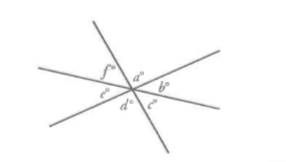In Fig.18 A,B,C are collinear point and ∠DBA= ∠EBA. (i) Name two linear pairs (ii) Name two pairs of supplementary angles.
To solve the problem step by step, we will first identify the linear pairs and then the supplementary angles based on the given information about the collinear points A, B, and C.
1. Understanding Linear Pairs:
- A linear pair consists of two adjacent angles whose non-common sides form a straight line. In other words, if two angles are adjacent and their other sides are opposite rays, they form a linear pair.
2. Identifying Linear Pairs:
- From the figure, we see that:
- Linear Pair 1: Angle ∠ABD and Angle ∠DBC are adjacent and their non-common sides (AB and BC) are opposite rays. Therefore, ∠ABD and ∠DBC form a linear pair.
- Linear Pair 2: Angle ∠ABE and Angle ∠EBC are also adjacent, and their non-common sides (AB and BC) are opposite rays. Thus, ∠ABE and ∠EBC form another linear pair.
3. Identifying Supplementary Angles:
- Supplementary angles are two angles whose measures add up to 180∘. Since every linear pair of angles is supplementary, we can conclude:
- Supplementary Pair 1: The angles ∠ABD and ∠DBC are supplementary because they form a linear pair.
- Supplementary Pair 2: The angles ∠ABE and ∠EBC are also supplementary for the same reason.
Final Answer:
(i) Two linear pairs are:
- ∠ABD and ∠DBC
- ∠ABE and ∠EBC
(ii) Two pairs of supplementary angles are:
- ∠ABD and ∠DBC
- ∠ABE and ∠EBC
- A linear pair consists of two adjacent angles whose non-common sides form a straight line. In other words, if two angles are adjacent and their other sides are opposite rays, they form a linear pair.
- From the figure, we see that:
- Linear Pair 1: Angle ∠ABD and Angle ∠DBC are adjacent and their non-common sides (AB and BC) are opposite rays. Therefore, ∠ABD and ∠DBC form a linear pair.
- Linear Pair 2: Angle ∠ABE and Angle ∠EBC are also adjacent, and their non-common sides (AB and BC) are opposite rays. Thus, ∠ABE and ∠EBC form another linear pair.
- Supplementary angles are two angles whose measures add up to 180∘. Since every linear pair of angles is supplementary, we can conclude:
- Supplementary Pair 1: The angles ∠ABD and ∠DBC are supplementary because they form a linear pair.
- Supplementary Pair 2: The angles ∠ABE and ∠EBC are also supplementary for the same reason.
(i) Two linear pairs are:
- ∠ABD and ∠DBC
- ∠ABE and ∠EBC
- ∠ABD and ∠DBC
- ∠ABE and ∠EBC
Topper's Solved these Questions
Similar Questions
Name the four pairs of supplementary angles shown in Fig.17.
View SolutionIn Fig.14, name all the pairs of adjacent angles.
View SolutionIn Fig. 15, write down: (i) each linear pair (ii) each pair of vertically opposite angles.
View SolutionIn Fig.19, name each linear pair and each pair of vertically opposite angles:
View Solution
If a and b are complementary angles (they sun to 90∘), name three other pairs of complementry angles .View SolutionCan two acute angles from a linear pair?
View SolutionIn Figure, A, B, C and D, E, F are two sets of collinear points. Prove that AD∣∣CF
View SolutionIn fig. 10, A,B,C and D are four points, and no three points are collinear. AC and BD intersect at O. there are eight triangle that you can observe. Name all the triangles.
View SolutionIn fig. 10, A,B,C and D are four points, and no three points are collinear. AC and BD intersect at O. there are eight triangle that you can observe. Name all the triangles.
View SolutionIn Fig (5.18) identify:(i) Five pairs of adjacent angles. (ii) Three linear pairs.(iii) Two pairs of vertically opposite angles
View Solution

